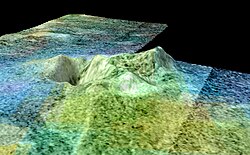Sotra Patera
 Stereoscopic map of Sotra Patera and Doom Mons. Height is exaggerated by a factor of 10. The colours are false. | |
| Feature type | Patera (planetary nomenclature) |
|---|---|
| Coordinates | 12°30′S 39°48′W / 12.5°S 39.8°W |
| Diameter | 235 km (146 mi) |
| Eponym | Sotra, Norway |
Sotra Patera (named after
The ice volcano or cryovolcano Doom Mons forms a roughly circular mountain measuring about 65 kilometres (40 mi) across. It has two peaks standing about 1,000 metres (3,300 ft) and 1,450 metres (4,760 ft) high with multiple craters, with Sotra Patera at 1,700 metres (5,600 ft) being the deepest. Finger-like flows are visible on the flanks of the mountain, measuring perhaps 100 metres (330 ft) thick.[3][4]

The
With Doom Mons, Sotra Patera is regarded as "the very best evidence, by far, for volcanic topography anywhere documented on an icy satellite", according to planetary scientist Jeffrey Kargel of the University of Arizona. It has been compared with terrestrial volcanoes such as Etna, Laki and volcanic cones near Flagstaff, Arizona. There is as yet no evidence of current activity, but researchers plan to monitor the area for changes.[3]
It is unclear what might have been erupted from Sotra Patera—possibly water mixed with
The eruptions of Sotra Patera are presumed to originate in a layer of liquid water lying below Titan's icy crust. The mountain's heavily cratered appearance indicates that it must have erupted with considerable force, but the precise mechanism by which this happened is not certain. Liquid water is ordinarily denser than ice but it is possible that the water's density may be reduced by mixing with other substances, such as ammonia, allowing it to force its way to the surface. Alternatively, some other mechanism such as the underground formation of methane bubbles or a build-up of tectonic pressure may be responsible.[5]
References
- ^ "Sotra Patera". Gazetteer of Planetary Nomenclature. USGS Astrogeology Research Program.
- ^ .
- ^ a b "Cassini Spots Potential Ice Volcano on Saturn Moon". NASA, December 14, 2010
- ^ a b c Lovett, Richard A. (2010-12-15). "Saturn Moon Has Ice Volcano—And Maybe Life?". National Geographic News. Archived from the original on December 17, 2010. Retrieved 2012-12-08.
- ^ a b c Castelvecchi, Davide. "Titan Spews: Discovery of Cold Volcanoes on Saturnian Moon May Solve Methane Mystery". Scientific American, December 16, 2010

